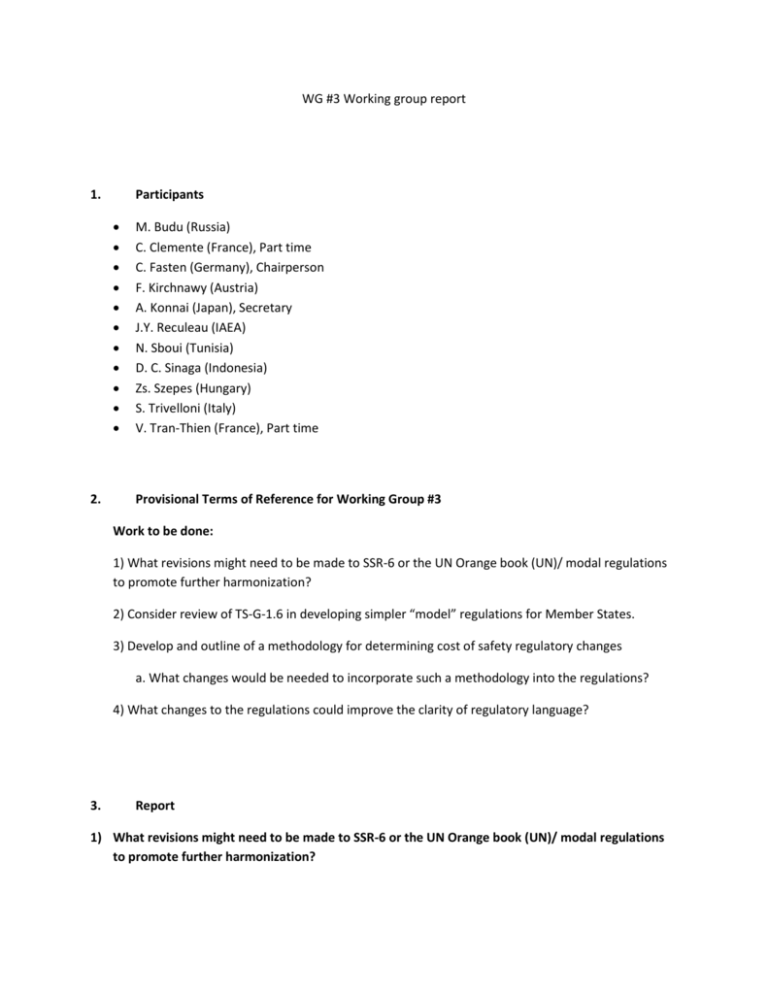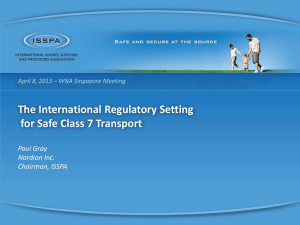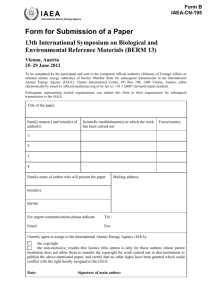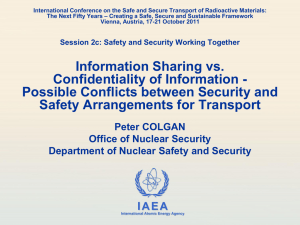draft report of WG3
advertisement

WG #3 Working group report 1. Participants 2. M. Budu (Russia) C. Clemente (France), Part time C. Fasten (Germany), Chairperson F. Kirchnawy (Austria) A. Konnai (Japan), Secretary J.Y. Reculeau (IAEA) N. Sboui (Tunisia) D. C. Sinaga (Indonesia) Zs. Szepes (Hungary) S. Trivelloni (Italy) V. Tran-Thien (France), Part time Provisional Terms of Reference for Working Group #3 Work to be done: 1) What revisions might need to be made to SSR-6 or the UN Orange book (UN)/ modal regulations to promote further harmonization? 2) Consider review of TS-G-1.6 in developing simpler “model” regulations for Member States. 3) Develop and outline of a methodology for determining cost of safety regulatory changes a. What changes would be needed to incorporate such a methodology into the regulations? 4) What changes to the regulations could improve the clarity of regulatory language? 3. Report 1) What revisions might need to be made to SSR-6 or the UN Orange book (UN)/ modal regulations to promote further harmonization? A. Harmonisation SSR-6, UN and modal regulations 1. Difference of requirements for UN Packing groups and IAEA types of packages (eg. Industrial Packages) 2. Certification requirements for non-approved package designs 3. Primary and subsidiary risk (technical basis for criteria) 4. Limited quantity, Excepted quantity vs Excepted package 5. Transport of samples (UNOB 2.0.4) 6. Salvage packaging (UNOB 4.1.1.18, 6.1.5.1.11) 7. Expand emergency provisions (304, 305 and 554 (c) of SSR-6) 8. Assessment of special provisions of UNOB, applicable for radioactive material 9. Segregation requirements and guidance for persons (public and workers), para 562 of SSR-6 B. Harmonisation between countries 1. Reduce differences between the state regulations and international safety standards 2. Mutual recognition of approval of package design 3. Extend “package design safety report” guide as a possible standard 2) Consider review of TS-G-1.6 in developing simpler “model” regulations for Member States. WG#3 has the opinion that TS-G-1.6 (Schedules) is not a format to make the model regulations simpler. For practical reasons, full text of the applicable modal regulations is needed. WG#3, however, has an opinion that Schedules is very useful for shippers and for training purpose for beginners. WG#3 recommends posting the electronic version of Schedules on the IAEA web site. Moreover the WG#3 recommends implementing the flow diagram of TS-G-1.6 into SSR-6, Section 4 (Classification) and also into UNOB, Chapter 2.7. Some corrections are needed before the implementation of the flow diagram, eg. UN 3507 shall be added. 3) Develop and outline of a methodology for determining cost of safety regulatory changes A methodology to determine cost of safety regulatory changes is useful for increasing the efficiency of the regulations both for governmental bodies and the industry. The governmental bodies nowadays, when some countries are affected by financial crisis, could benefit from such assessments in raising the efficiency of their budget expenses, saving important sums that could be allocated for more personnel, better qualifications etc. The resources of industry can be used in a more cost effective way. The prerequisite required for developing a detailed and complete methodology to determine cost of transport safety regulatory changes is to initially have a baseline cost estimation for the implementation of all provisions contained in SSR-6. This full scope implementation cost estimate for SSR-6 could be made for simplified regulatory framework models in terms of conservatism, statistics and relevance for the world wide stage, should comprise all types of RAM, packages, shipment modes etc. and could be based on a reference currency like Special Drawing Rights, so that it could be easily adapted for each particular country. The cost of each (case by case) transport safety regulatory change can then be estimated following a few main steps: 1. Identification of information The input information required for developing a cost estimation for a regulatory change is: - administrative regulatory information: bodies involved in the regulatory process, procedures and interactions between them, manpower and technical (physical) resources required for each procedure (example: modification of certificate vs. new certificate issuance); - financial regulatory information: is the regulatory body working as a service-tariff self financed body, or is it financed from the state budget? What are the tariff/budget expenses for each regulatory procedure? - based on transports statistics proportional coefficients shall be determined for material categories, package types, modes of transport etc. These coefficients help refining the cost impact of regulatory provisions. - determination of appropriateness and form of the proposed changes. Result: bodies, procedures, manpower, regulatory costs (budgetary or tariff based), coefficients for materials, packages, modes of transport, identified change. 2. Proper categorization of the analyzed transport safety regulatory change For the intended regulatory change all the affected regulatory procedures and the change cost impact should be identified (less manpower+more technical resources? Example: usage of electronic systems). If the regulatory change affects several radioactive materials/package types/transport modes, then the proportion coefficients determined at point 1 should be applied in determining the overall cost of the change implementation. Another aspect to be taken into consideration for a proper characterization of the change: is it an administrative change only (organizational change), does it impact package design, associated equipment, safety case demonstration or existing packagings/conveyances/equipment that are involved in transport? A questionnaire or a diagram can be developed in support for a correct categorization of a regulatory change. Result: a selection of impacted procedures, administrative/technology impacting change, one or several selected impacted materials/packages/modes of transport. 3. Cost calculation For each element determined at point 2 a new implementation cost shall be determined. Since the factors involved in determining the implementation cost for one or another regulatory provision can vary independently one from the other during a change (manpower, technical resources, equipment etc.), then the new implementation cost may result bigger or smaller than the baseline cost estimation in an unforeseeable way. For this reason each cost factor (human resources, technical resources, financial, legal, training etc.) should be reassessed while calculating the new implementation cost. Result: new implementation cost 4. Cost assessment At this step the new implementation cost is analyzed against the baseline implementation cost and against the possible expenses resulted from not implementing the respective change. Conclusions and recommendations should be elaborated at the end of this step. Result: conclusions and recommendations a) What changes would be needed to incorporate such a methodology into the regulations? To incorporate a methodology for determining cost of safety regulatory changes it is necessary to develop a new safety guide at IAEA level with the involvement of all member states. Afterwards a monitoring of the safety guide implementation at state level by the means of organizing workshops for obtaining permanent feedback and experience exchange (lessons learned) could be useful for the further application and incorporation of such methodology in SSR-6. IAEA requires that for the review of SSR-6, it is necessary to have an estimated cost for each proposal (see 6. in the submission form): “6. Justification of proposed change State expected cost of implementation (negligible, low, medium or high). Add detail as necessary.” WG#3 recommends making this cost estimation following a graded approach. See also annex The Cost driven Approach to Regulatory burdens (CAR). 4) What changes to the regulations could improve the clarity of regulatory language? - Clear definitions, no requirements in the definitions Consistent use of definition (eg. Licence vs certificate, approval) One requirement per one paragraph Standards for legislation: use of shall, should, must, might - Use of “and” and “or” Not doubling of negative words Short, precise and concise sentences Clear punctuation More visual things, e.g. flow diagrams, tables Avoid cross references, if possible (rewrite, if short regs) Furthermore, WG#3 recommends the following means to improve the clarity of the regulatory language: - Inter-agency group Translation conference (for 6 UN-languages)







